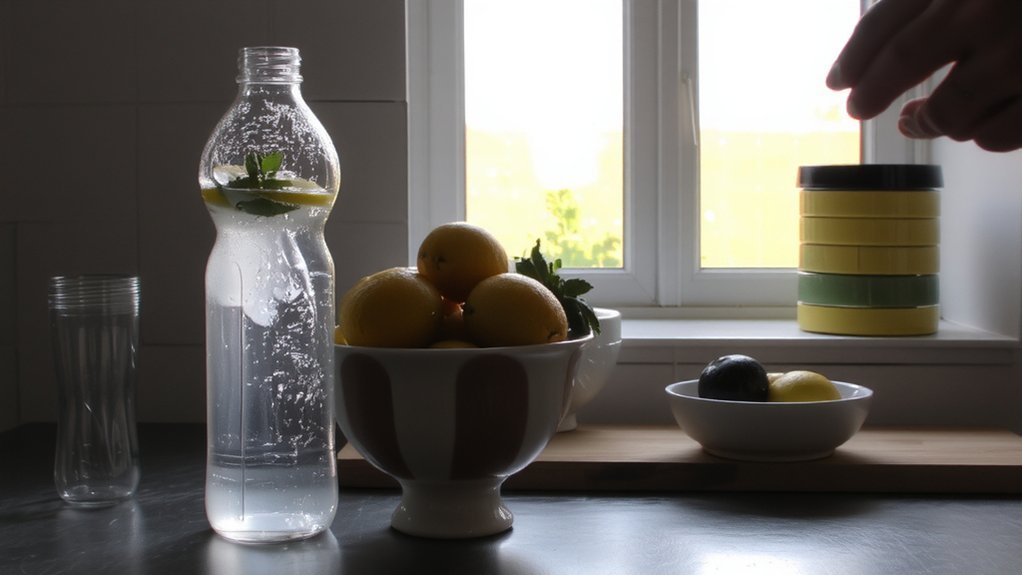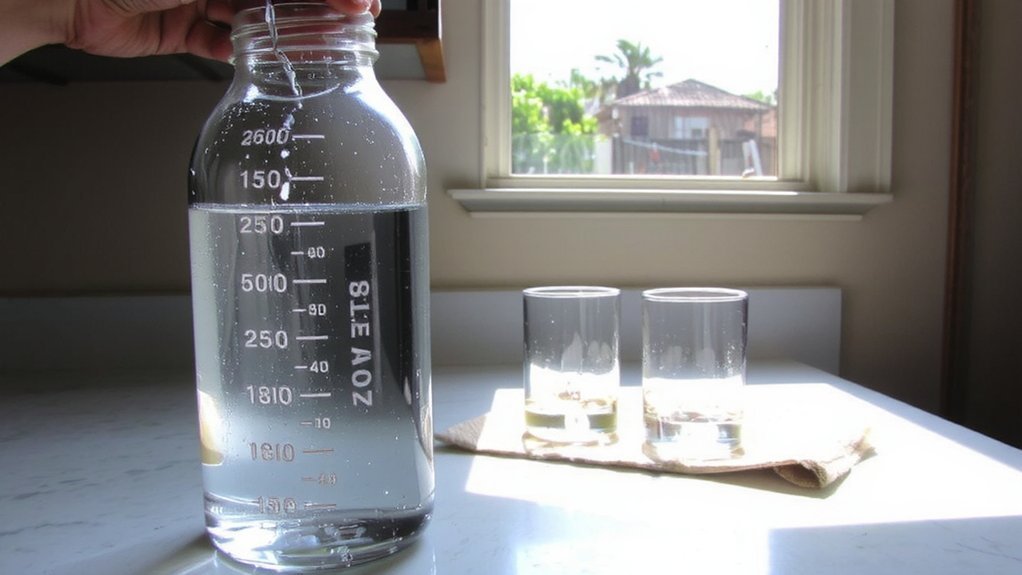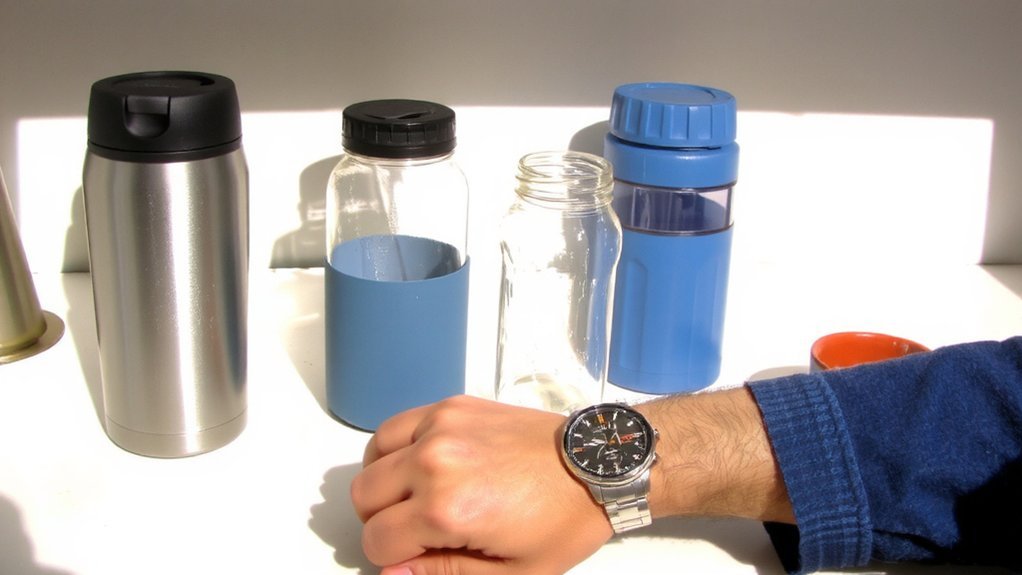If you want to drink more water daily, you can make it a simple part of your routine with a few small changes. You’ll feel better, think clearer, and cut calories by swapping sugary drinks. Keep a bottle nearby, tie sips to habits, and use quick tracking tricks—there’s a handful of practical tweaks that make it stick…
Why Drinking More Water Matters for Your Health

Because your body depends on water for nearly every function, staying hydrated helps you think clearer, keep energy steady, and digest food efficiently.
You’ll notice better concentration, faster reaction times, and steadier mood when fluids are adequate. Water supports circulation, cushions joints, and regulates temperature so you move and recover with less strain.
It helps your kidneys flush waste, reducing fatigue and lowering headache risk. Proper hydration keeps skin supple and aids nutrient transport to cells, so you perform daily tasks more comfortably.
You’ll also support metabolic processes that break down food and maintain electrolyte balance without overloading organs. Small, consistent sipping habits prevent dips in performance and make healthy routines easier to sustain.
They’ll fit into your day and boost long-term wellbeing too.
How Much Water Should You Aim For Daily

A simple daily target is a useful starting point: aim for about 2 to 3 liters (roughly 8–12 cups) of fluids a day for most adults, adjusting up for heat, exercise, pregnancy, or illness.
Your precise need depends on body size, activity, and climate.
A common alternative is about 30–35 ml per kg of body weight — multiply your weight in kg by that range to estimate personal needs.
Include water from foods and beverages when calculating totals. Monitor hydration by checking urine color (pale straw is ideal) and noting persistent thirst, dry mouth, or dark urine as signs to drink more.
If you have medical conditions or take medications, ask your clinician for a tailored recommendation. Seek adjustments during travel or heavy sweating.
Simple Habits to Make Water a Routine

Often you’ll build hydration into your day by tying sipping to habits you already have: keep a filled bottle within reach, drink a glass after every bathroom break or before each meal, set simple phone alarms or use a habit app, and pair water with routines like commuting or morning coffee so it becomes automatic.
Choose a bottle you like and keep it where you work and relax.
Flavor water with citrus or herbs if plain water bores you.
Swap one sugary drink per day for water.
Use cues — standing up, finishing a task, or arriving home — to prompt a sip.
Make refilling easy: identify nearby taps, keep a spare bottle, and make hydration part of social moments so it feels natural.
Practical Ways to Track Your Daily Intake

How will you know if you’re meeting your hydration goals?
Use simple, consistent tracking so you can adjust intake.
Pick one method: a hydration app that logs ounces and reminds you, a dedicated water journal where you tick off servings, or a reusable bottle with volume markings you mark each refill.
Set hourly mini-goals—finish one marked section by mid-morning, another by lunch—to distribute intake.
Use a daily checklist or habit tracker to build streaks and review weekly totals.
If you prefer low-tech, keep tally marks on a sticky note or set phone alarms labeled “water.”
Review progress each evening and tweak goals based on activity, climate, or how you feel.
Tracking keeps hydration intentional.
Celebrate small wins to stay motivated and adjust as needed.
Choosing the Right Bottle and When to Sip

Where you keep your water and which bottle you use determine how often you’ll sip.
Pick a bottle that fits your routine: a lightweight one for commuting, an insulated bottle for long outings, and a wide-mouth bottle if you like adding ice.
Choose a size you can realistically finish between refills and one that seals to prevent spills.
Keep it visible, on your desk, in your bag, or beside your bed, so you remember to drink.
Sip habitually: take a few sips every 20 to 30 minutes, drink before and after tasks, and have a small refill goal each hour.
Set alarms or link sips to actions like standing up.
Consistent, small sips beat occasional gulps.
You’ll notice steady improvement with simple, regular sipping.
Boosting Hydration With Foods and Other Drinks
Including water-rich foods and hydrating beverages helps you meet fluid goals without forcing constant sipping. Eat fruits like watermelon, strawberries, and oranges, and veggies such as cucumber, lettuce, and celery; these add water and electrolytes.
Add broth-based soups and smoothies to meals for extra fluids and nutrients. Sip herbal teas, decaffeinated green tea, or infused water for variety; they’ll count toward your intake.
Limit alcohol and high-sugar drinks, which can dehydrate or add empty calories. If you struggle with plain water, dilute juice with sparkling water or keep frozen fruit in your glass to chill and flavor it.
Track combined fluids from foods and drinks so you hit daily targets without rigid routines. Small swaps across meals steadily raise hydration without dramatic habit changes.
Tips for Staying Hydrated During Exercise and Heat
When you’re exercising or spending time in high heat, you lose water and electrolytes through sweat, so plan to drink before, during, and after activity.
Start by sipping 12–16 ounces (350–475 ml) about 2 hours before exercise and another 6–8 ounces (175–240 ml) 20–30 minutes prior.
During workouts aim for 4–8 ounces (120–240 ml) every 15–20 minutes, adjusting for intensity and sweat rate. For long or intense sessions, use a drink with electrolytes to replace sodium and potassium.
After activity, rehydrate with water and include a snack or drink containing carbohydrates and sodium to speed recovery. Watch urine color as a quick gauge — pale yellow indicates good hydration.
Dress appropriately, seek shade, and pace yourself in high heat. Carry a refillable bottle always.
Overcoming Common Barriers to Drinking Water
If you struggle to drink enough, you’re not alone — common barriers include forgetfulness, dislike of plain water, busy schedules, limited access, and frequent bathroom worries.
Put a filled bottle where you’ll see it, set phone alarms, and tie sipping to habits like meals or commuting.
If plain water puts you off, add slices of citrus, cucumber, or a splash of juice.
Carry a lightweight, leakproof bottle and refill at work or public water stations.
Plan quick access during long meetings or trips so you won’t skip fluids.
If bathroom concerns hold you back, time your drinks between long commitments and use restroom breaks proactively.
Track intake with a simple app or marks on your bottle to stay accountable.
Reward yourself for consistency weekly.
Safe Strategies for Increasing Fluid Intake Gradually
How quickly should you ramp up your fluids? Increase intake slowly: add one extra cup (240 ml) a day for a week, then another.
Spread sips across the day rather than gulping.
Use a reusable bottle with timed targets and set alarms.
Replace one sugared drink with water to cut calories while boosting hydration.
Monitor urine color—pale straw is good— and note any swelling, dizziness, or rapid weight change.
If you take diuretics or have heart or kidney disease, check with your clinician before increasing fluids.
Include electrolyte-rich foods or a balanced sports drink if you’re sweating heavily.
Adjust for activity, heat, and body size.
Small, consistent changes let your body adapt safely.
Celebrate progress and revisit goals weekly to stay on track consistently.
Conclusion
You can make drinking water a simple, lasting habit. Start with a realistic daily target, keep a filled bottle nearby, and link sips to routines like meals or breaks. Flavor water or swap one sugary drink for a glass. Track progress with marks, apps, or alarms, and increase intake gradually for activity and heat. If you have health concerns, check with your clinician. Stick with small changes and you’ll stay better hydrated each day now.